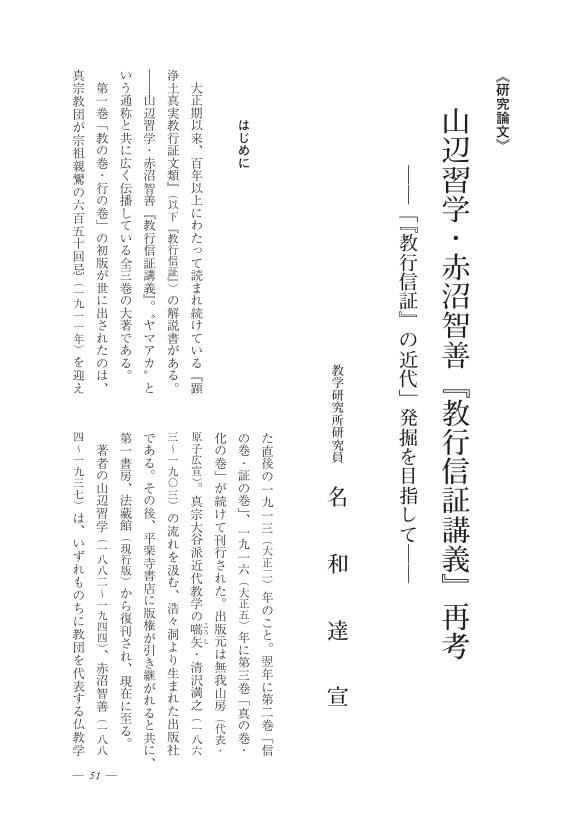4 0 0 0 OA 西田幾多郎と『教行信証』
- 著者
- 名和 達宣
- 出版者
- 宗教法人 真宗大谷派 親鸞仏教センター
- 雑誌
- 現代と親鸞 (ISSN:13474316)
- 巻号頁・発行日
- vol.31, pp.67, 2015 (Released:2018-04-04)
3 0 0 0 OA 親鸞教学と京都学派の交流する場所 曽我量深を基点として
- 著者
- 名和 達宣
- 出版者
- 宗教哲学会
- 雑誌
- 宗教哲学研究 (ISSN:02897105)
- 巻号頁・発行日
- vol.37, pp.16-29, 2020-03-31 (Released:2020-07-09)
In Japan, no Buddhist sect founder is as popular as Shinran today in terms of the reach of his teachings, which has come to be accepted across all different schools. In relation to this phenomenon, the writer shall try to seek answers to two key questions: 1) why Shinran? And 2) what is the truth of “Shinran” referred to by everyone? With these questions in mind, this paper shall try to uncover a place for sharing between Shinran’s Doctrinal Studies and the Kyoto School based on the thoughts of Soga Ryojin, who has exerted great influence over the doctrinal studies of modern Shinshu Otani-ha. Despite being a researcher of Shinran’s Doctrinal Studies, the writer has chosen to focus on the Kyoto School due to the fact that the philosophers of this particular group have come to learn Shinran’s thinking and devised their own line of thoughts through his key publication, Kyogyoshinsho, as opposed to Tannisho, which was compiled by followers of Shinran and is better known by most people in modern Japanese society. This paper shall seek to explore “The Possibility of Philosophy of Religion in Pure Land Buddhism” by comparing Soga’s interpretation of a passage called “Sangan-Tennyu” from Kyogyoshinsho against the thinking of Hajime Tanabe, Yoshinori Takeuchi, and Kitaro Nishida.
3 0 0 0 OA 「三願転入」論の波紋
- 著者
- 名和 達宣
- 出版者
- 宗教法人 真宗大谷派 親鸞仏教センター
- 雑誌
- 近現代『教行信証』研究検証プロジェクト研究紀要 (ISSN:24337536)
- 巻号頁・発行日
- vol.2, pp.125-177, 2019 (Released:2019-07-31)
1 0 0 0 OA 山辺習学・赤沼智善『教行信証講義』再考 「『教行信証』の近代」発掘を目指して
- 著者
- 名和 達宣
- 出版者
- 宗教法人 真宗大谷派 親鸞仏教センター
- 雑誌
- 近現代『教行信証』研究検証プロジェクト研究紀要 (ISSN:24337536)
- 巻号頁・発行日
- vol.1, pp.51-86, 2018 (Released:2019-07-31)
1 0 0 0 OA 『教行信証』解釈の〈方法〉をめぐって(上) 「親鸞教学」としての方法は如何
- 著者
- 名和 達宣
- 出版者
- 宗教法人 真宗大谷派 親鸞仏教センター
- 雑誌
- 近現代『教行信証』研究検証プロジェクト研究紀要 (ISSN:24337536)
- 巻号頁・発行日
- vol.4.5, pp.117-161, 2022 (Released:2022-03-22)
1 0 0 0 西田哲学と親鸞教学:「逆対応」の可能性
- 著者
- 名和 達宣
- 出版者
- 西田哲学会
- 雑誌
- 西田哲学会年報 (ISSN:21881995)
- 巻号頁・発行日
- vol.12, pp.96-115, 2015
In recent years there have been many studies that look at the relationship between the philosophies of Nishida Kitaro and Shinran, however, only a very small number explore this relationship from the perspective of Shinran's Doctrinal Studies. One can see in Nishida a deep affinity with Shinran from an early age, expressed for example in his 1911 essay Gutoku Shinran. Also, in his Zen no kenkyū("An Inquiry into the Good"), released in the same year, one can see in the fourth section, which deals with religion, a possible influence from contemporary modern Shinran's Doctrinal Studies pioneer Kiyozawa Manshi (1863―1903). After that, Nishida very rarely directly mentions Shinran, right up until his later years. However, I believe that even if Shinran is not visible on the surface one can perceive a note in Nishida's underlying philosophy that resonates with Shinran's doctrine. And, I believe that note takes full form in one of his last works, 1945's Basho-teki ronri to shūkyō-teki sekai-kan("The Logic of Place and the Religious Worldview"). The study I present here will center itself around the philosophical concept of "Inverse Correspondence" and argue the Shinran's Doctrine is revealed in Nishida's discussion of the relationship between the infinite other and the finite individual self.
- 著者
- 名和 達宣
- 出版者
- 宗教法人 真宗大谷派 親鸞仏教センター
- 雑誌
- 現代と親鸞 (ISSN:13474316)
- 巻号頁・発行日
- vol.31, 2015
1 0 0 0 OA 書評 岡田勝明著『悲哀の底― 西田幾多郎と共に歩む哲学』
- 著者
- 名和 達宣
- 出版者
- 西田哲学会
- 雑誌
- 西田哲学会年報 (ISSN:21881995)
- 巻号頁・発行日
- vol.15, pp.180-184, 2018 (Released:2020-01-29)
1 0 0 0 OA 西田哲学と親鸞教学 「逆対応」の可能性
- 著者
- 名和 達宣
- 出版者
- 西田哲学会
- 雑誌
- 西田哲学会年報 (ISSN:21881995)
- 巻号頁・発行日
- vol.12, pp.96-115, 2015 (Released:2020-03-21)
In recent years there have been many studies that look at the relationship between the philosophies of Nishida Kitaro and Shinran, however, only a very small number explore this relationship from the perspective of Shinran’s Doctrinal Studies. One can see in Nishida a deep affinity with Shinran from an early age, expressed for example in his 1911 essay Gutoku Shinran. Also, in his Zen no kenkyū(“An Inquiry into the Good”), released in the same year, one can see in the fourth section, which deals with religion, a possible influence from contemporary modern Shinran’s Doctrinal Studies pioneer Kiyozawa Manshi (1863―1903). After that, Nishida very rarely directly mentions Shinran, right up until his later years. However, I believe that even if Shinran is not visible on the surface one can perceive a note in Nishida’s underlying philosophy that resonates with Shinran’s doctrine. And, I believe that note takes full form in one of his last works, 1945’s Basho-teki ronri to shūkyō-teki sekai-kan(“The Logic of Place and the Religious Worldview”). The study I present here will center itself around the philosophical concept of “Inverse Correspondence” and argue the Shinran’s Doctrine is revealed in Nishida’s discussion of the relationship between the infinite other and the finite individual self.




